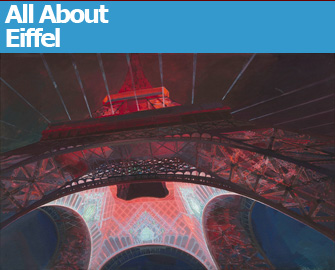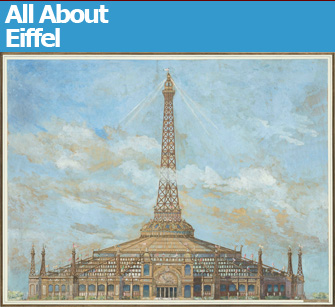 |
| André Granet: “Illumination of the Eiffel Tower for the Exposition Universelle of 1937.” © RMN (Musée d’Orsay / © Hervé Lewandowski |
“Gustave Eiffel: Le Magicien du Fer,” a new exhibition at Paris’s Hôtel de Ville celebrating the iconic tower’s 120th anniversary, has something for everyone. Engineers and architects can marvel at the inventiveness …
 |
|
Henri Toussaint’s never-realized plan to add a |
“Gustave Eiffel: Le Magicien du Fer,” a new exhibition at Paris’s Hôtel de Ville celebrating the iconic tower’s 120th anniversary, has something for everyone. Engineers and architects can marvel at the inventiveness and technical prowess exhibited in beautifully rendered plans for bridges and other structures, including some that were never built, such as an “underwater bridge” under the English Channel. Art lovers can admire a plethora of paintings, drawings, prints and photographs of the tower by renowned artists, among them Robert Delaunay, Raoul Dufy, Fernand Léger and Man Ray, as well as documentary images of its construction. History and trivia buffs can revel in many curious facts about the tower and biographical info on the man himself.
And, just when you thought you knew everything there was to know about what must be the world’s most potent symbol of a city, you learn something new. The other designs entered into the competition for a tower for the Exposition Universelle of 1889, for example, were strikingly similar to Eiffel’s, not surprising since the guidelines for the competition called for “an iron tower with a square base… and a height of 300 meters.” And it turns out that Eiffel didn’t actually design the tower himself but bought the patent for it from two of the engineers working for his own firm, Maurice Kœchlin and Émile Nouguier, who had designed it in 1884.
Then there are the wonderful drawings for a competition held for the Paris Exposition Universelle of 1900. Entrants were told they could either replace the tower, save it or transform it. They came up with some fanciful (to say the least) ideas for dressing up the tower for the new century: adding an elaborate metal skirt around its lower levels (pictured above), turning it into a mountain (complete with roads, trees, villages, viaducts and a waterfall flowing into the Seine, which could have been very interesting), building a sort of temple adorned with huge statues around it, transforming it into a pyramid, prettifying it with flags and other decorations, and so on.
We also learn that Eiffel pioneered a number of innovative bridge-building techniques and was an expert in prefabrication, and that he designed the inner structure of the Statue of Liberty for sculptor Frédéric-Auguste Bartholdi. After his retirement, he devoted the last three decades of his life to research, conducting aerodynamic and aeronautic experiments and inventing, among other things, wind tunnels to test his theories (one, in Auteuil, still functions) and a high-speed fighter plane.
Thankfully, in spite of the fact that the “odious” tower, described by Joris-Karl Huysmans as a “solitary suppository riddled with holes” was detested by much of the public in the early days (the exhibition includes a petition against it signed by dozens of luminaries of the day, including Charles Garnier [architect of the Paris opera house] and Guy de Maupassant), none of the abovementioned plans was adopted, and Eiffel’s tower was saved in all its beautiful starkness, mainly because a telegraph antenna was installed on top of the 300-meter-high tower in 1905, making it an essential structure rather than just a curiosity.
The funny thing about Eiffel, as the exhibition points up, is that while his tower and other designs may have been avant-garde and even revolutionary, there was nothing the least Guevara-like about the man himself, who scorned modern art and lived in a seriously bourgeois town house stuffed with plush, ornate furniture like all good burghers during the Belle Epoque.
Another exhibition with similar themes, “L’Epopée de la Tour Eiffel,” is being held on the first floor of the tower itself through December 21. And this year’s Bastille Day fireworks, to be set off from the tower, should be quite a spectacle.
Hôtel de Ville: Salle Saint Jean, 5, rue de Lobau, 75004 Paris. Métro: Hôtel de Ville. Monday-Saturday, 10 a.m.-7 p.m. Closed on Sunday and public holidays. Admission: free. Through August 29.
Buy related books and films from the Paris Update store.
More reviews of current art exhibitions.
Reader reaction
Click here to respond to this article (your response may be published on this page and is subject to editing).
© 2009 Paris Update
Favorite